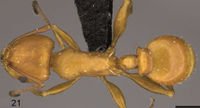Nesomyrmex capricornis
| Nesomyrmex capricornis | |
|---|---|

| |
| Scientific classification | |
| Kingdom: | Animalia |
| Phylum: | Arthropoda |
| Class: | Insecta |
| Order: | Hymenoptera |
| Family: | Formicidae |
| Subfamily: | Myrmicinae |
| Tribe: | Crematogastrini |
| Genus: | Nesomyrmex |
| Species group: | hafahafa |
| Species: | N. capricornis |
| Binomial name | |
| Nesomyrmex capricornis Csösz & Fisher, 2015 | |
This species is known to occur in small, highly isolated forests (Toliara, Forêt Mahavelo and Parc National d’Andohahela, Forêt de Manantalinjo) in the southern part of Madagascar.
Identification
A member of the hafahafa species-group. The three pairs of dorsal spines (pronotal spines, propodeal spines and antero-dorsal spines on petiolar node) makes the appearance of this group extremely unique; no similar species group has been found either in the Malagasy region or on the African continent.
Keys including this Species
Distribution
Latitudinal Distribution Pattern
Latitudinal Range: -24.758° to -24.817°.
| North Temperate |
North Subtropical |
Tropical | South Subtropical |
South Temperate |
- Source: AntMaps
Distribution based on Regional Taxon Lists
Malagasy Region: Madagascar (type locality).
Distribution based on AntMaps
Distribution based on AntWeb specimens
Check data from AntWeb
Countries Occupied
| Number of countries occupied by this species based on AntWiki Regional Taxon Lists. In general, fewer countries occupied indicates a narrower range, while more countries indicates a more widespread species. |

|
Estimated Abundance
| Relative abundance based on number of AntMaps records per species (this species within the purple bar). Fewer records (to the left) indicates a less abundant/encountered species while more records (to the right) indicates more abundant/encountered species. |

|
Biology
Castes
Nomenclature
The following information is derived from Barry Bolton's Online Catalogue of the Ants of the World.
- capricornis. Nesomyrmex capricornis Csösz & Fisher, 2015: 47, figs. 19-21 (w.q.m.) MADAGASCAR.
Unless otherwise noted the text for the remainder of this section is reported from the publication that includes the original description.
Description
Worker
Body color: yellow. Body color pattern: Body concolorous, only clava darker. Absolute cephalic size: 1024 [919, 1115] μm (n=27). Cephalic length vs. maximum width of head capsule (CL/CWb): 1.079 [1.037, 1.111]. Postocular distance vs. cephalic length (PoOc/CL): 0.390 [0.381, 0.403]. Postocular sides of cranium contour frontal view orientation: converging posteriorly. Postocular sides of cranium contour frontal view shape: broadly convex. Vertex contour line in frontal view shape: straight. Vertex sculpture: main sculpture rugose, ground sculpture areolate. Gena contour line in frontal view shape: convex. Genae contour from anterior view orientation: converging. Gena sculpture: rugo-reticulate with areolate ground sculpture. Concentric carinae laterally surrounding antennal foramen count: absent; present. Eye length vs. absolute cephalic size (EL/CS): 0.241 [0.225, 0.267]. Frontal carina distance vs. absolute cephalic size (FRS/CS): 0.315 [0.297, 0.326]. Longitudinal carinae on median region of frons count: present. Longitudinal carinae on medial region of frons shape: forked. Smooth median region on frons count: absent. Antennomere count: 12. Scape length vs. absolute cephalic size (SL/CS): 0.927 [0.907, 0.948]. Facial area of the scape absolute setal angle: setae absent, pubescence only. Median clypeal notch count: present. Median clypeal notch depth vs. absolute cephalic size (Cdep/CS): 0.023 [0.018, 0.030]. Ground sculpture of submedian area of clypeus: smooth. Median carina of clypeus count: present. Lateral carinae of clypeus count: present. Median anatomical line of propodeal spine angle value to Weber length in lateral view: 65–70°. Spine length vs. absolute cephalic size (SPST/CS): 0.397 [0.367, 0.432]. Minimum spine distance vs. absolute cephalic size (SPBA/ CS): 0.260 [0.238, 0.292]. Apical spine distance vs. absolute cephalic size (SPTI/CS): 0.455 [0.386, 0.569]. Propodeal spine shape: straight; slightly bent. Apical distance of pronotal spines vs. absolute cephalic size (PSTI/CS): 0.658 [0.617, 0.690]. Metanotal depression count: absent. Dorsal region of mesosoma sculpture: areolate ground sculpture, superimposed by dispersed rugae. Lateral region of pronotum sculpture: areolate ground sculpture, superimposed by dispersed rugae. Mesopleuron sculpture: areolate ground sculpture, superimposed by dispersed rugae. Metapleuron sculpture: areolate ground sculpture, superimposed by dispersed rugae. Petiole width vs. absolute cephalic size (PEW/CS): 0.265 [0.238, 0.312]. Anterodorsal spines on petiolar node angle of deviation from each other: 60°. Apical distance of anterodorsal spines on petiolar node vs. absolute cephalic size (NSTI/CS): 0.265 [0.203, 0.364]. Frontal profile of petiolar node contour line in lateral view shape: straight; concave. Dorso-caudal petiolar profile contour line in lateral view shape: strongly convex. Dorsal region of petiole sculpture: ground sculpture areolate, main sculpture dispersed rugose; ground sculpture areolate, main sculpture absent. Postpetiole width vs. absolute cephalic size (PPW/CS): 0.558 [0.516, 0.613]. Dorsal region of postpetiole sculpture: ground sculpture areolate, main sculpture absent; ground sculpture areolate, main sculpture dispersed rugose.
Type Material
Holotype worker. CASENT0452741, collection code: BLF05245; MADGAGASCAR: Prov. Toliara, Forêt Mahavelo, Isantoria Riv., 5.2 km 44°NE Ifotaka, 24°46'S, 46°09'E [-24.75833N, 46.15717E], 110 m, 28.iii.2002 Fisher et al. (California Academy of Sciences); Paratypes. Ten workers, a single gyne and two males with the same label data with the holotype (CAS).
Etymology
This species is named for the shape of the anterodorsal spines on the petiolar node, which resemble goat horns.
References
References based on Global Ant Biodiversity Informatics
- Csosz S., and B. L. Fisher. 2015. Diagnostic survey of Malagasy Nesomyrmex species-groups and revision of hafahafa group species via morphology based cluster delimitation protocol. ZooKeys 526: 19–59.

